4 Social Media Platforms to Start Advertising Your Business
In this guide, you will learn about the benefits of advertising on social media, the four most popular social media platforms, and how to effectively use them to advertise your business.
What is Social Media Advertising?
Social media advertising is a type of digital marketing where you market your business on social media platforms such as Facebook, Instagram, Twitter, Youtube, and Linkedln. Social media advertising can boost your brand’s awareness and is a fast and effective way to reach and connect with your audience.
The latest data shows that the average person spends about 149 minutes on social media daily. Social media is, therefore, a good opportunity for brands to showcase their products or services.
The use of social media varies between gender, age, country, race, education level, and many other factors.
It is, therefore, essential to know which social media platform to use to reach your target audience. Aligning your content strategy with the right audience on the right platform can significantly impact how effective your marketing is.
What are the Benefits of Advertising on a Social Media Channel?
Quick & Measurable ROI
Advertising on social media channels can generate quick results, which you can easily measure. You can measure how well your campaign is doing from the traffic on your ad, the number of sales generated, new followers gained and so on.
If used well, social media advertising can yield a higher ROI than many traditional marketing strategies such as TV or radio commercials, billboards, and print media.
Rich in Database
Data shows that 59.3% (4.74 billion) of the world population were social media users by October 2022, and this number continues to grow with time. Therefore, advertising on social media can reach a vast number of people and increase your brand awareness with less effort than it would take for traditional media.
Specific Targeting Options
Social media platforms have features that can enable you to customise your ads to a specific niche of people. This allows marketers to consistently reach their intended audience.
Less Prone to Ad Frauds
Unlike ads on websites that are open for click farming, social media channels are less prone to ad fraud. Statistics show that there is a 25% lower likelihood of fraud attempts for in-app advertising than on the web. Reduced ad fraud means that your ads reach the target audience while protecting your brand’s reputation.
Use Customer-Generated Content for Ads
Social media channels enable users to provide feedback on your product and services, which can be used as content in your ads. This is referred to as user-generated content (UGC) and can be very impactful in driving purchases.
Do A/B Testing Easily
A/B testing is a method used in marketing to test how well your audience reacts to variations in the different content of your ad; for example, you can make changes in the headline or the images and see how the audience responds. Unlike traditional media, you can do A/B testing on social media, allowing you to determine which strategy is most effective for your ads.
Reach out to Similar Audiences
Social media ads can be programmed to reach audiences with similar interests based on their search interests or other factors.
Engage and Grow your Fan Base
Social media advertising allows you to grow an audience which can become instrumental in promoting your brand to new customers. Since social media ads are targeted, they feel more personalised to users, which can strengthen the sense of community around your brand.
What are the trade-offs of advertising on social media channels?
Low Intent – Involves More Creativity
Most users are on social media for entertainment and have no intention of purchasing anything. Therefore, advertising on social media channels requires more creativity to make interesting content that will capture the audience’s attention. This process can be very time-consuming and sometimes very expensive.
Keeping Up With Current Trends
Social media marketing requires you to constantly keep up with the ever-evolving trends. This requires you always to know what your customers love and produce content that aligns with those desires.
Requires Time to Master
Social media marketing is a modern skill that doesn’t yet have seasoned professionals. If you don’t outsource your strategy to an agency, it takes significant time to train a social media manager in-house.
Susceptible to Brand Name Being Tarnished
Due to the volatile nature of the internet, negative incidences can easily go viral and tarnish your brand name.
The 4 most popular social media platforms for advertising
For an effective marketing strategy, starting with the most popular platforms is best, after which you can venture into smaller platforms.
The four most popular social media platforms right now are:
- Youtube
Facebook Advertising
Brief Introduction of the Channel
Facebook is the largest social media platform, with nearly two-thirds (2.93 billion) of social media users actively using it worldwide. It is, therefore, an excellent platform for advertising your business.
Facebook ads were launched in 2007 to allow marketers to be part of the conversation with the consumers instead of just pushing ads to them.
Facebook advertising allows you to create online ads targeted at your audience on the platform. Facebook ads can also reach users via other platforms connected to Facebook, such as Instagram.
Characteristics of the Channel
- Low-intent users
People usually go to Facebook for leisure activities, including chatting with friends or family. Therefore, most Facebook users have a low buying intent, which impacts marketing on the platform.
- Good visual experience
Facebook ads provide an excellent visual experience with a good combination of images and text.
- Wide targeting options and rich in user data
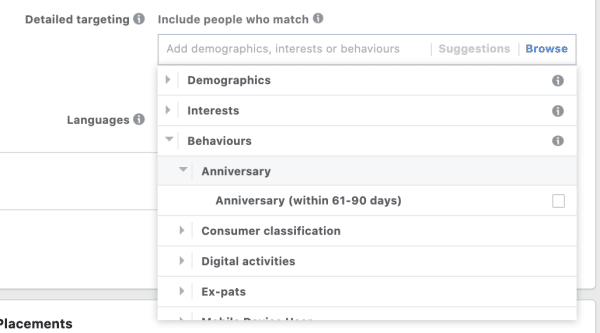
Facebook has a wide variety of targeting options that allow you to target your audience based on features like their demographics, interests, and behaviour.
An illustration of how to use the targeting option feature
- People-Based Advertising
Facebook ads can be customised to individuals instead of groups, a type of marketing known as people-based advertising. Ads are sent to a specific person depending on their past behaviour on the platform.
Audience on the Channel
Facebook has tools you can use to select your audience. There are three types of audiences: core, custom, and lookalike audiences.
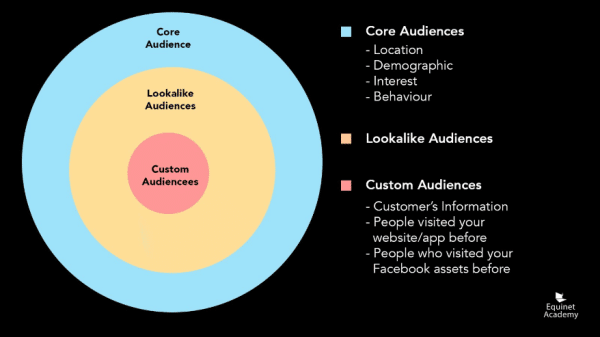
- Core audiences
Here you can make your target audience broad or define it to specific characteristics. The core audience can be based on location, like cities or countries where you want to conduct your business; demographic factors like age and gender; peoples’ interests and hobbies; behaviour such as previous purchases; or their connections to your Facebook page.
- Custom audiences
These are users who already have a connection to your business, such as past customers or people who visited your website or installed your app.
- Lookalike audiences
You can target new people with similar interests to those of best customers, and these are known as lookalike audiences. This is an effective way to find new customers that are highly likely to respond to your ad.
Price & Targeting Options
Facebook has a limited number of spots for ads that can run on the app in order to avoid overloading the audience. Businesses, therefore, compete for the limited ad spots on the app and the Facebook algorithm decides whether an ad will be shown and how much the advertiser will pay.
Brands with similar products and targeting similar audiences compete against each other for the ad spots, and a winner is chosen based on the total value of their ad (how much the target audience will engage with the ad).
The total value of the ad is based on three factors; price (the advertiser bid), user value (the quality and relevance of the ad), and estimated action rates (how many people will take actions such as commenting or sharing the ad).
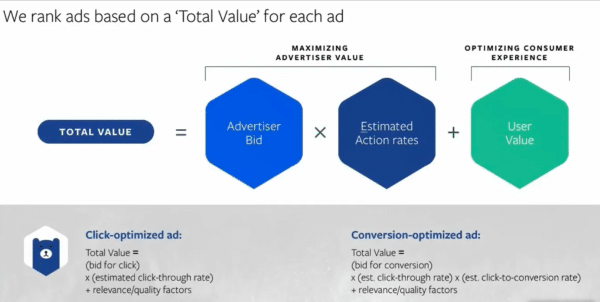
Source: Shopify
The price of ads increases with an increase in the number of competitors. For this reason, ads tend to be more expensive for businesses like insurance, finance, and home improvements due to the high competition. The competition also rises during seasons like Black Friday and Christmas, which hike ad prices.
On average, Facebook ads cost $1.06 per click (CPC) and $14.40 per mille (CPM). CPM refers to the price of an ad per 1000 impressions.
Targeting your intended audience on Facebook is another essential factor to consider because it will determine who sees your ads to improve their effectiveness. Targeting can also lower your cost by only targeting the interested individuals.
There are several options to consider when selecting your target audience. Facebook has a long list of interests, including factors like fitness and wellness, technology, entertainment, sports, and so on.
Pros & Cons
Like any advertising media, Facebook ads have pros and cons that you should consider to optimise your marketing strategy.
| PROS | CONS |
| 1. Micro-targeting
2. Wider reach 3. Precise targeting options 4. Cost effective 5. Conversion measurement |
1. Requires technical expertise and time to master the platform
2. Fraudulent users 3. Requires a lot of creativity to get results 4. High competition |
Advertising Tips
Below are some advertising tips you can use to make your Facebook ads more effective:
- Unique creatives based on audience targeting. Create outstanding ads tailored to your audiences’ interests, for example, posting a post that celebrates a holiday relevant to them.
- Build brand awareness, then use retargeting. Use the retargeting feature to get in touch with users who have shown interest in your brand.
- Implement A/B testing. To get the most out of your ads, conduct A/B testing to determine which ad strategies work best.
- Exclude audiences. Set up targeting rules to exclude audiences you don’t want to show your ads to, such as existing customers. This can help you save costs as the ads will only be delivered to the most relevant audience.
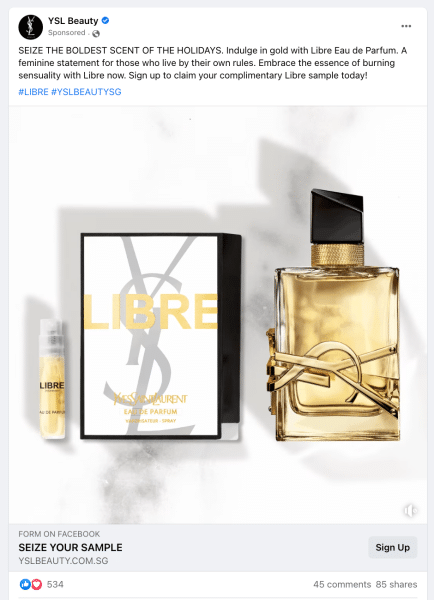
Source: YSL Beauty Facebook
Instagram Advertising
Brief introduction of the channel
Instagram is one of the four main apps owned by Meta (formerly Facebook). It is one of the top downloaded mobile apps on both Android and iOS, with over 2 billion active users worldwide. Instagram can be a great platform to market your business through visual organic content or by running ads that can be shown in your target audience’s feed.
Characteristics of the Channel
- Good visual experience. Instagram is a photo and video-sharing platform known for its visually appealing content. It is an excellent platform for B2C companies, particularly those in visual industries like beauty and fashion.
- Popular with younger users. Instagram is mainly popular among young users, with 62.2% of its users aged 18-34 years. It would, therefore, be a great platform if that is your target audience.
- Mobile photo-sharing app. Instagram is designed for photo/video sharing and is great for advertising products that use visual content. It also has a shopping feature that allows people to visit your shop and browse through your products without leaving the app.
Audience in the channel
Most of the audience on Instagram are Millennials and Gen Z-ers, and is generally more popular among females than males. As Instagram is owned by Meta, it shares the same advertising manager as Facebook which offers some of the best targeting features on social media.
Price & targeting options
The average cost per click on Instagram is $0.80. This can vary with competition based on the industry, where the price can increase in more competitive industries like clothing; demographics of your target audience like age, gender, and country; your ad placement, such as the desktop feed or stories; and time of advertising like the month, day of the week or holiday seasons.
The same system runs Instagram ads as Facebook ads and, therefore, has a similar process of determining their costs. The ads are run through an auction system which determines how much they will cost. Various ads bid for the auction, and to determine which ad wins, three factors are considered:
- Advertiser bid. This is the maximum CPC the advertiser is willing to pay.
- Estimated action rates. The likelihood of your audience engaging with the ad and taking the desired action.
- Ad quality and relevance. This refers to the significance of your ad to the users.
Instagram also has targeting options that can help you reach an audience more interested in your services. You can target your audience based on location, demographics, interests, and habits. This can help lower your CPC and can also increase your sales.
Pro & Cons
| PROS | CONS |
| 1. High usage stats
2. Price targeting options 3. Wider reach 4. The audiences are more primed to purchase/discover new products 5. Increased visibility |
1. Less advanced features than Facebook
2. A user’s feed features a lot of posts, making the ads less visible 3. The audience is mainly limited to certain demographics 4. Difficult to keep up with its algorithm |
Advertising Tips
- Use images of real people instead of stock images. Similar to any social media site, audiences on Instagram resonate more with photos of real people than generic stock images.
- Hashtags. Use hashtags in your posts as this can help increase your audience. However, it’s essential not to overdo it. Use 7-10 hashtags to avoid cluttering your caption.
- Visuals evoke emotions for impulse buying. Use compelling visuals in your ad that can evoke emotions in your audience. You can also include irresistible offers in your ads to increase engagement from your audience.
- Capture your audience’s attention. Ensure to include an engaging intro in the first three seconds of your ad. These moments are extremely vital since social media users tend to have short attention spans.

A festive ad from luxury brand Hermes
LinkedIn Advertising
Brief introduction of the channel
LinkedIn is a social network just like Instagram and Facebook, but unlike the rest, it is meant for professional networking and career development. Owned by Microsoft, it is the world’s largest professional networking site, with over 875 million users in more than 200 countries worldwide.
Characteristics of the channel
- The only B2B targeting platform. Many businesses have profiles on LinkedIn, making it a great platform for B2B marketing. You can put ads on Linkedln to target professionals and generate leads for B2B big spenders.
- Professional Mindset. Unlike other networks where people go for entertainment, LinkedIn users mainly devote their time to connecting with brands and discovering what is happening in their industries.
- People are more authentic on LinkedIn. LinkedIn accounts are generally more authentic than other social networking platforms since it acts as a digital resume to find work or business opportunities.
Audience in the channel
LinkedIn is a great platform to reach business professionals. Many of the users on the site are affluent professionals and decision-makers with high incomes. This makes it especially great for pricier services that may not be affordable to the typical TikTok user.
Price & Targeting options
Linkedln, like other social platforms, has features that enable you to target your ads to certain audiences. However, its targeting options are different and more advanced. Instead of targeting audiences based on interests and behaviour, LinkedIn focuses on the user’s professional profile.
LinkedIn users’ profiles are resumes with their job titles, work experience, and recommendations. You can, therefore, target your audience by job title, industry, education level, professional expertise, current employer, and the groups they are in.
Due to its professional nature, LinkedIn ads are more expensive compared to other social networks. The average cost per click is $5.58, and this varies depending on three factors:
- Target audience. If your ad targets an audience in high demand, it can increase your ad price due to the competition.
- Bid. Advertisers set bids when auctioning for an ad, and your bid will impact your ad cost. Bidding on Linkedln is a second-price auction, which means you don’t pay the price your bid for your ad; however, the auction winner pays the minimum required to beat the second-highest bidder, which is set at one cent more than their bid.
- Ad relevance. Linkedln ensures that the ads posted serve their users; therefore, the more relevant your ad is, the lower your ad costs.
Pros & Cons
| PROS | CONS |
| 1. Authentic users
2. Trusted platform due to its professionalism 3. Respectful conversations 4. Less clutter increasing the chances of your ad being seen 5. Brand safety 6. Advanced targeting |
1. Higher ad prices
2. Not suitable for B2C business 3. Linkedln users spend less time on the platform compared to other social platforms 4. It is limited to certain countries |
Advertising Tips
- As Linkedln users visit the platform for professional purposes, tailor your ads to solve professional problems and challenges.
- Target your audience based on job titles, company, seniority, education, and skills to increase engagement.
- Conduct A/B testing to increase the effectiveness of your ad.
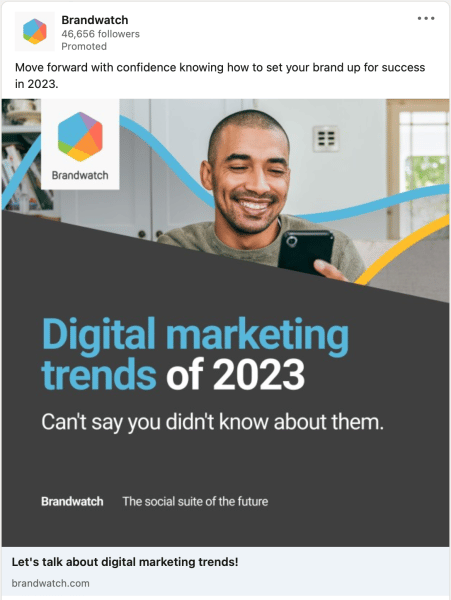
LinkedIn is especially ideal for marketing B2B services.
YouTube Advertising
Brief introduction of the channel
YouTube is an online video-sharing platform that is currently owned by Google. It is the second most-used search engine after Google and the third-largest social media platform in the world.
Characteristics of the channel
- Content is shared through videos. YouTube content is in video and is, therefore, an excellent platform for video ads.
- High-tech video features. Being a video-first site, YouTube has great video features that allow for an optimised user experience. These features include subscriptions, comments, and communities.
Audience in the channel
YouTube has a variety of audiences with various interests, demographics, and intents. Stats for 2022 show that 54.4% of YouTube users are males and most of the audience is aged 25 to 34.
Price & targeting options
The cost of your YouTube ad will depend on your user activity. YouTube has two pricing models: cost-per-click and cost-per-view, which average $0.10 to $0.30 per click or view. You can set the maximum amount you want to spend on an ad per day to ensure you stay on your budget.
The cost of your ad can be determined by various factors:
- Ad type. The type of ad you run determines your ad costs. For example, if you choose skippable ads, viewers can skip the ad after five seconds, and if they skip, you are not charged.
- Your bid. This directly affects how much you spend on the ad since it is the price you are willing to pay.
- Targeting options. Your ad cost will also depend on your target audience. YouTube has various targeting options, including demographics, interests (which can be based on what someone views), keywords, and remarketing based on one’s past interactions with your videos.
Pros & Cons
| PROS | CONS |
| 1. It has precise targeting options
2. It’s a great channel for content distribution 3. Users spend more time on the platform which increases their chances of your ad getting viewed. 4. YouTube has analytics that enables you to track your ad performance |
1. Requires technical expertise and time to master the platform
2. Lack of control over the content your ads appear with 3. Low conversion rates. Data shows that 65% of users skip commercials and even when they view them, there is no guarantee of a sales click. |
Advertising Tips
- Create great stories or videos, using AI animation generator to capture the attention of your audience and increase engagement.
- Ensure that your video quality is good to improve the viewer experience.
- Create an eye-catching YouTube intro that will make your audience continue watching.
- Include a clear call to action.
- Choose your ad type wisely.
- Make use of the YouTube targeting options.
YouTube remains one of the leading platforms for video ads
How to manage a social media advertising campaign
With the high numbers of people on various social media platforms, advertising on social media has become vital in growing your business. Therefore, it is crucial to have the right skills to manage a social media advertising campaign.
Audience, business objectives, budget
When starting a social media campaign, ensure that you know your target audience to optimise engagement and save costs. This can easily be done through the various targeting options on social media platforms.
Define the goals and objectives of your social media ads so you can develop the right strategies to achieve them. This can be increasing brand awareness, connecting with your audience, increasing traffic on your website, or increasing sales. For example, if the objective of your campaign is to improve awareness, then you can run your ads on various platforms with little to no targeting.
Having a budget is another crucial factor in managing a social media campaign. Budgeting will enable you to plan better on what strategies to use to attain the goals of your campaign. For example, the budget can determine what type of ad you can run, how many platforms you can use, and how much content to include in the ads.
Pros & Cons of In-house vs Out-source Marketing
| IN-HOUSE | OUT-SOURCE |
| PROS
1. More control, transparency, and accountability 2. More knowledge and understanding of the company culture and goals |
PROS
1. More attention and expertise 2. More experience with different companies, giving them exposure to various ideas |
| CONS
1. May lack experience and expertise 2. May suffer tunnel vision from working in the same company 3. May be costly to have a full-time team with expertise in various fields |
CONS
1. Lack of control, transparency and accountability. 2. Difficult to decide on the right agency to do the job 3. Lack of in-depth understanding of the company culture and goals |
Case Study: Pandora Germany
Brand Introduction
Pandora is one of the most prominent jewellery brands, with over 100 stores worldwide. They are mainly known for their charm bracelets but also produce other pieces such as necklaces, earrings, and rings.
Approach
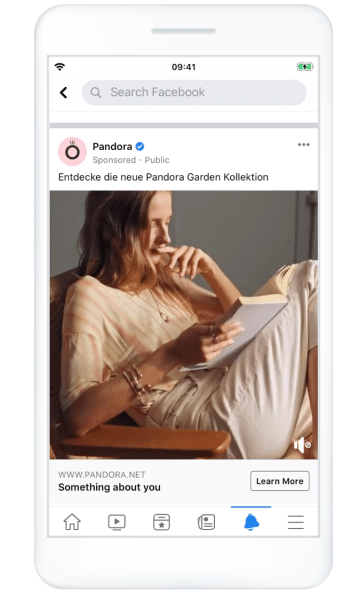
Source: Facebook
Although an already popular brand, Pandora Germany used Facebook and Instagram to raise brand awareness through various ad types, including dynamic ads and photo ads. The ads were targeted mainly towards women and users who were perceived to be interested in the brand.
Results
The ad reached over 3 million people and introduced the jewellery brand to many new customers. The result was a 93% increase in brand awareness.
Conclusion
When running a social media advertising campaign, you need a comprehensive strategy to ensure your ad attains your goal. Make sure to understand who your target audience is and the right platform to find them.
If targeting is appropriately done, effective results can be achieved. It can take time for businesses to fully understand the intricacies of the system on the various platforms, but with time and experience, you will surely improve with results that are worth the hard work.
If you want to learn more about digital advertising, sign up for our Digital Advertising course. We also hold a Certified Digital Marketing Strategist Programme, which covers the following six modules:
- Digital Marketing Strategy
- Content Marketing Strategy
- Search Engine Optimisation
- Digital Advertising
- Social Media Marketing
- Digital Marketing Analytics with Google Analytics
The completion of these modules will lead the learners to attain a Certified Digital Marketing Strategist Certificate. All of these courses are WSQ accredited and available for up to 70% subsidy.